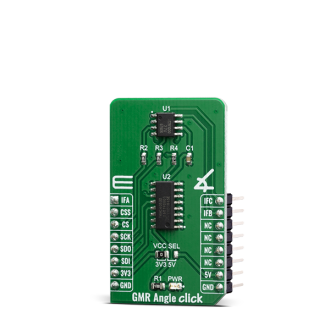
We strongly encourage users to use Package manager for sharing their code on Libstock website, because it boosts your efficiency and leaves the end user with no room for error. [more info]

Rating:
Author: MIKROE
Last Updated: 2019-11-06
Package Version: 1.0.0.0
mikroSDK Library: 1.0.0.0
Category: Magnetic
Downloaded: 3398 times
Not followed.
License: MIT license
The GMR Angle Click is a Click board that features the TLI5012B E1000, which is a 360° angle sensor that detects the orientation of a magnetic field, made by Infineon.
Do you want to subscribe in order to receive notifications regarding "GMR Angle click" changes.
Do you want to unsubscribe in order to stop receiving notifications regarding "GMR Angle click" changes.
Do you want to report abuse regarding "GMR Angle click".


Library Description
The library covers all the necessary functions to control GMR Angle click board. A library performs a standard SPI interface communication.
Key functions:
uint16_t gmrangle_readData( uint8_t registerAddress ) - Generic read 16-bit data function.void gmrangle_writeData( uint8_t registerAddress, uint16_t writeData ) - Generic write 16-bit data function.float gmrangle_calculateAngle() - Calculate angle function.Examples description
The application is composed of three sections :
void applicationTask()
{
angle = gmrangle_calculateAngle();
FloatToStr( angle, logText );
mikrobus_logWrite( " Angle is ", _LOG_TEXT );
mikrobus_logWrite( logText, _LOG_TEXT );
mikrobus_logWrite( degCel, _LOG_LINE );
mikrobus_logWrite( "---------------------", _LOG_LINE );
Delay_1sec();
}
Other mikroE Libraries used in the example:
Additional notes and informations
Depending on the development board you are using, you may need USB UART click, USB UART 2 click or RS232 click to connect to your PC, for development systems with no UART to USB interface available on the board. The terminal available in all MikroElektronika compilers, or any other terminal application of your choice, can be used to read the message.